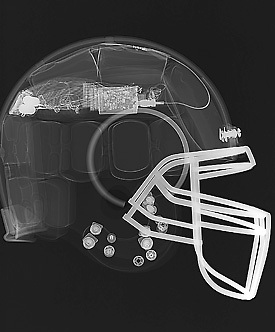While studying concussions in a high school football team, researchers captured the impact of an 18-year-old player who broke his neck during a head-down tackle in real-time.
Steven Broglio, an assistant professor in the School of Kinesiology, studies concussive impacts. His lab is the high school football field. The injured student in the study in Illinois healed and was cleared 12 weeks later to play basketball, Broglio says.

An X-ray of a football helmet outfitted with the Head Impact Telemetry System, used to study concussion. HITS fits into the top of the helmet and wirelessly transmits impact data to a sideline computer. Photo by Steven Broglio.
Click image for a larger version
Though other researchers have captured concussion impact data in humans, this is believed to be the first time these data have been captured for a spinal fracture. The data appears July 20 in a letter in the New England Journal of Medicine.
It is rare for a high school or college student to suffer a broken neck; the bigger, more common problem in youth athletics is concussion. However, most of the media attention and research has focused on professional sports, Broglio says.
“To us, the larger public health issue is with the 1.5 million high school kids that play football each year. Not the 1,500 that play in the NFL,” Broglio says.
The student-athletes in Broglio’s study wear helmets outfitted with padded sensors called the Head Impact Telemetry System. The HITS uses the same type of sensor that activates a car air bag and wirelessly transmits the location and magnitude of that impact to a sideline computer 10-20 seconds later.
Eventually, Broglio would like to see a similar system used as diagnostic tool to record linear acceleration, rotational acceleration and impact location on every athletic field.
“Ultimately, we’re trying to use these measures to predict concussion,” Broglio says. “If someone exceeds a certain level then we would know they have a concussion and we could pull them.” Broglio stresses that this technology is years away from becoming a reality.
In this particular player’s case, it was obvious that something serious had occurred, Broglio says. However, the impact he sustained wasn’t as hard as others have sustained in the four-year study who weren’t concussed.
Researchers suspect each athlete’s body reacts differently to impact, but the average for concussion is about the same across high school, college and professional. A concussion occurs at roughly 90 to 100 g-force, “which is like smashing your head against a wall at 20 mph,” Broglio says. The shuttle launch is about 3 g-force; a rolling fighter pilot about 5-10 g-force.
Broglio also found that a high school football player takes about 652 impacts over a 12-13 week season. “I challenge you to find a parent who will tell their kid to bang their head against the wall 652 times in 12 weeks,” Broglio says. “It’s an interesting way to think about it.”
In the 120,000 impacts recorded over four years at Unity High School in Illinois, 25 were concussions and one a broken neck. Broglio recently was approved to continue the study at Skyline High School in Ann Arbor.


